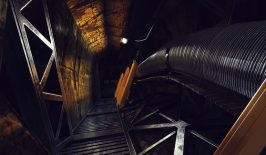While the concept of storing thermal energy in molten salt has been around for decades, a new approach – from one of Google’s sister companies – combines hot energy with cold to create a temperature difference that can be utilised to generate power.
Alphabet Inc, Google’s parent company, has developed the technology within its secretive “Moonshot Factory”, known simply as X. Ideas in this lab sometimes don’t become commercially viable, while others take off. We’ve previously covered one success story – the company Dandelion, a geothermal approach to heating and cooling your home, current operating in New York State.
The latest project to emerge as a funded company is Malta. With the Breakthrough Energy Coalition providing significant funding, a partnership between major high-net wealth individuals including Bill Gates, Jeff Bezos, Jack Ma, and many more, Malta is now out of the lab.
The aim of the project is to develop a battery for the grid, where renewable energy – from solar or wind – can be stored for later use.
In a first step, renewable energy is gathered from the grid in the form of electrical energy and sent to the Malta energy system. The power from is then delivered to a heat pump – in this case, a Brayton heat engine. This generates both a hot and a cold stream of air, creating a temperature difference. These are then sent to separate vats and stored as thermal energy – the heat stored in molten salt and the cold in antifreeze-like liquid.
When electrical energy is required by the grid, combining the two fluids generates a high-velocity torrent, which can be used to spin a turbine, much like high-pressure steam, to create electricity. That creates contained, reversible, and cost-effective energy generation on demand. The molten salt remains blisteringly hot for many hours, while the cold liquid has been engineered to remain at sub-freezing temperatures – and the elements can be re-used multiple times, Malta claiming for as long as 20 years.
The project based on research done by Robert Laughlin, a Nobel prize-winning physicist, with technical insights published in 2017 in the Journal of Renewable and Sustainable Energy. While the concept is familiar within the field of thermodynamics – but losses and costs have generally seen other energy storage systems win out.
“The thermodynamic physics are well-known to anyone who studied it enough in college,” said Julian Green, the product manager for Project Malta at the time, told Bloomberg. “The trick is doing it at the right temperatures, with cheap materials. That is super compelling.”
Malta’s approach offers another set of ideas in the world of energy storage, and at megawatt scale. A pilot plant will be built to fully prove out the work.
A World of Unique Energy Storage
Energy storage is a massive industry. Pumped storage offers one of the most simple approaches currently in use and is currently being implemented all over the world. During times of cheaper electricity, water is pumped uphill into a high-elevation dam. During higher energy demands, water rushes downhill through turbines, generating hydroelectic power. This requires two or more dams at different elevations, which may occur naturally, or can be constructed.
RESET has reported on plenty of other unique energy storage ideas, including one of my favourites, from the Fraunhofer Institute, which suggests giant concrete balls on the bottom of the sea or in lakes could be the batteries of the future. In terms of direct competition to Malta, an Australian listed company, 1414 Degrees, stores energy as heat using molten salt for later electrical generation, while also aiming to re-use the stored heat for district heating or in industry for manufacturing, or even in greenhouses.
The details around Malta’s first pilot plant are next to none. It’s expected to be in the megawatt range, but to ultimately become a cheap and reliable way to store the renewable energy currently being generated, and reduce the need for gas peaker plants, it will need to scale to hundreds of megawatts.






